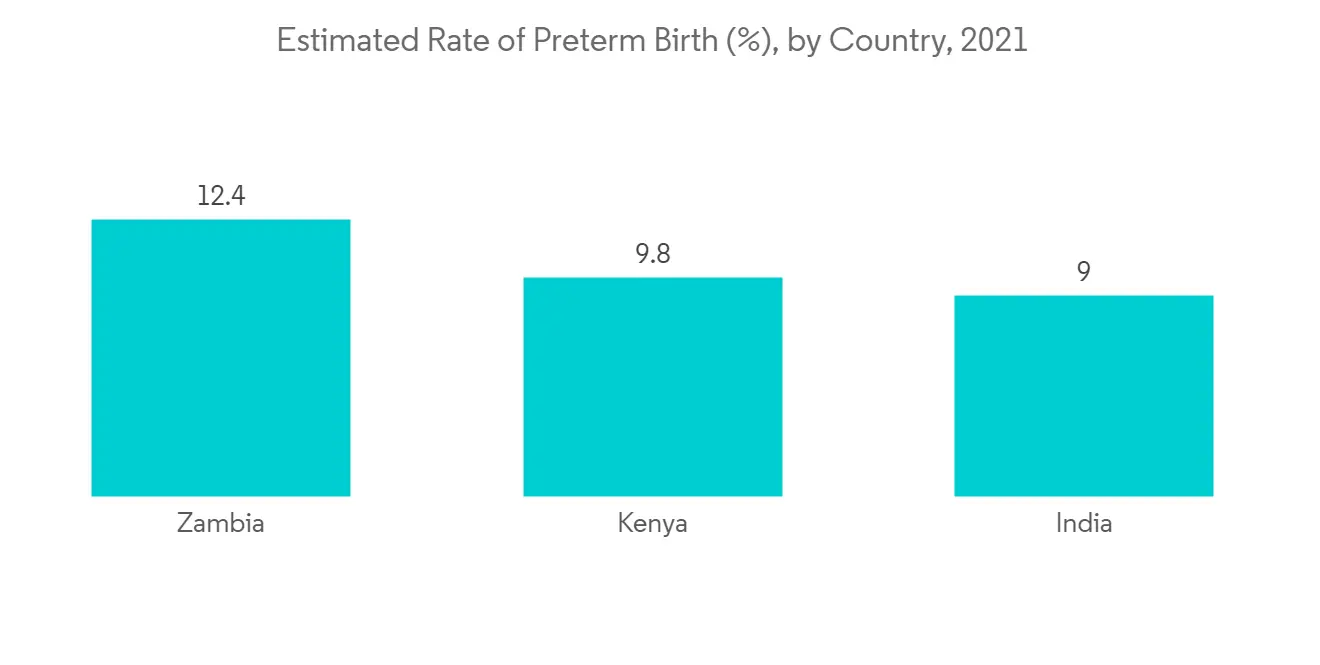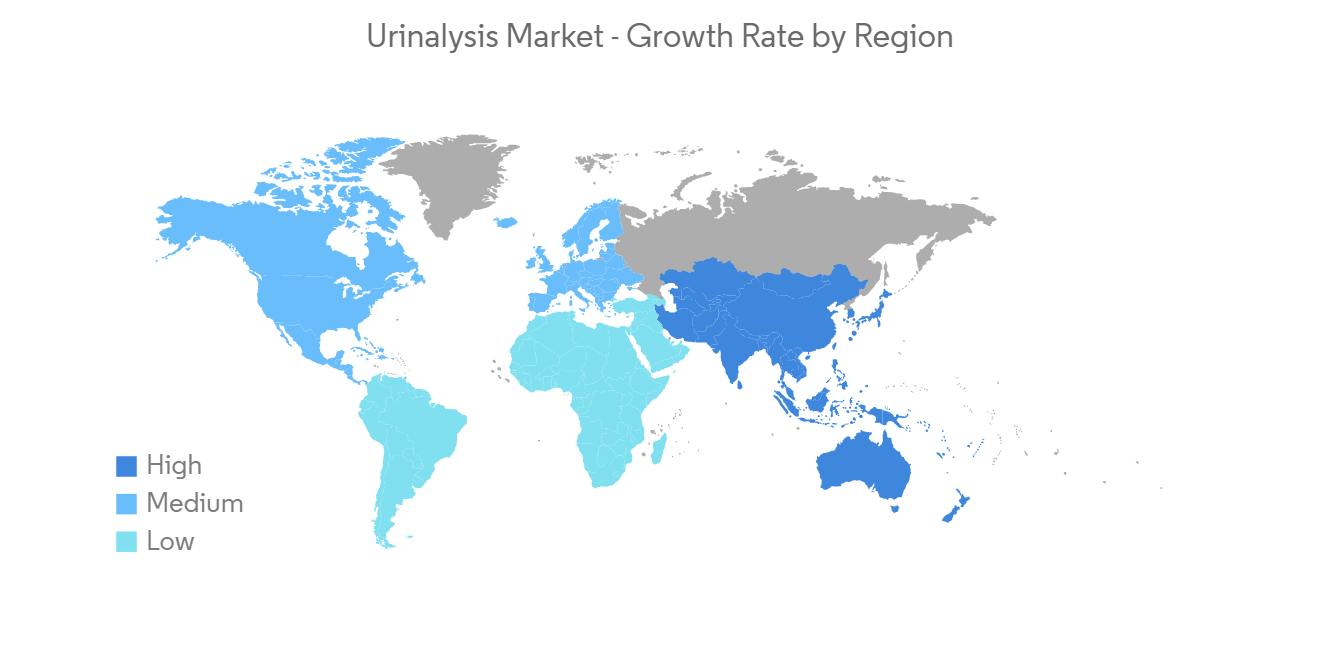 |
市场调查报告书
商品编码
1273504
尿液分析市场 - 增长、趋势和预测 (2023-2028)Urinalysis Market - Growth, Trends, and Forecasts (2023 - 2028) |
||||||
※ 本网页内容可能与最新版本有所差异。详细情况请与我们联繫。
在预测期内,尿液分析市场预计将以 7.5% 的复合年增长率增长。
COVID-19 爆发影响了尿液分析市场,因为医院和医疗保健服务因社会疏远而限制了服务。 冠状病毒感染患者的空前增加减少了获得其他初级保健服务的机会,并显着减少了非 COVID-19 相关诊断,如尿路感染和肾臟疾病。 例如,根据 2021 年 7 月发表在《国际外科杂誌》上的一篇研究论文,在 COVID-19 大流行期间延迟或推迟的泌尿外科手术包括尿路感染、压力性尿失禁、膀胱过度活动症 (OAB)、神经源性膀胱等。 同样,2021 年 12 月发表在 ADIAN Journal 上的一项研究发现,接受初级保健服务的患者更少,诊断也更少,包括尿路结石。 同一消息来源还表示,在 2020 年 3 月 30 日至 4 月 24 日期间,英格兰每週每 10 万人的尿路结石诊断率从平均 30-35 人下降到不到 10 人。 自 4 月以来,它比正常情况增加了 50%。 因此,在大流行期间,市场出现了不利影响。 然而,由于放鬆管制和 COVID-19 病例减少,市场已开始蓄势待发,预计在预测期内将继续呈上升趋势。
糖尿病和慢性肾病等慢性病负担的增加、即时检测适应症的扩大等预计将成为市场增长的主要驱动力。 尿路感染是影响泌尿系统任何部分的感染。 例如,根据国际糖尿病联合会 (IDF) 2021 年 12 月更新,2021 年约有 5.37 亿 20-79 岁的成年人患有糖尿病,到 2030 年将有 6 亿。预计到 2045 年将增加到 4300 万和 7.83 亿. 据同一消息来源称,四分之三的成人糖尿病患者生活在低收入和中等收入国家,其中近二分之一(2.4 亿)未被确诊。 根据同一消息来源,2021 年将有 670 万人死于糖尿病。 尿液分析已被证明是确定糖尿病患者葡萄糖水平的重要测试。
此外,全球慢性肾病病例的增加预计也将在预测期内推动市场增长。 例如,慢性肾病(CKD)是一种肾功能在一段时间内下降的疾病。 它可以发展多年并导致终末期肾病 (ESRD)。 这是一个巨大的公共卫生问题。 例如,美国疾病预防控制中心 2021 年的一份报告估计,美国超过 15.0% 的成年人(约 3700 万人)患有 CKD。 同样,由国际肾脏病学会 (ISN) 和国际肾臟基金会联合会 (IFKF) 联合组织的 2021 年世界肾臟日发布的数据显示,肾臟疾病影响着全球约 8.5 亿人。 同一份文件还报告说,每 10 个成年人中就有 1 个患有慢性肾病 (CKD)。 CKD 的全球负担持续增加,预计到 2040 年将成为全球损失生命年的第五大原因。
虽然市场有望增长,但与尿液分析相关的严格监管框架可能会阻碍预测期内的市场增长。
尿液分析市场趋势
预计在预测期内怀孕和不育面积将显着增长
尿液分析可用于诊断糖尿病、脱水、肾臟或膀胱感染以及先兆子痫。 高血糖可能是妊娠糖尿病的征兆,可能出现在怀孕第 20 週左右。 人绒毛膜促性腺激素 (hCG) 是一种独特的激素,仅在怀孕期间才会在女性体内产生,并可在妊娠试验中检测到。 这些测试可以在血液和尿液中寻找 hCG。 怀孕的家庭尿液检测价格实惠且受欢迎。 如果正确完成,家庭妊娠试验是相当准确的。
越来越多地使用尿液检测来检测怀孕和不孕症,预计将推动这一细分市场的增长。 已经进行了几项研究来了解尿检确定怀孕的准确性。 例如,美国国立卫生研究院在 2021 年 9 月发表的一篇论文指出,导致患者尿液妊娠试验 (UPT) 假阴性的原因一般有两种可能,我来了。 早孕病例是指患者可能无法产生足够的人绒毛膜促性腺激素 (hCG) 而呈阳性。 从 15 到 100 mIU/mL 的阈值代表第一种也是最可能的情况。 其次,更令人担忧的是,晚期妊娠患者可能会出现“钩子效应”(hCG 的升高或过量会淹没尿液妊娠试验,从而导致假阴性)。 虽然也有尿检呈阴性的情况,但它是怀孕的首选检查。 此外,主要参与者继续推出妊娠试验也有望促进这一细分市场的增长。 例如,2022年4月,Mankind Pharma推出了一款用于验尿确认怀孕的快速验孕仪。

预计在预测期内北美将占很大份额
由于社会老龄化和慢性肾脏病的高患病率,预计北美将占据全球尿液分析市场的很大份额。 慢性肾病与肾功能衰竭有关。 根据国家肾臟基金会发布的 2021 年数据,慢性肾脏病导致的死亡人数超过乳腺癌或前列腺癌。 根据同一数据,约有 3700 万人受到影响。 它在老年人中很常见,影响了大约 15.0% 的成年人口。 因此,该地区需要对慢性肾脏病进行适当的诊断和治疗,这有望推动对尿液分析的需求。
主要产品的发布、市场参与者和製造商的高度集中、主要参与者之间的收购和合作以及美国尿石症和慢性肾病病例的增加将推动该国尿液分析市场的增长。部分因素。 例如,2021 年 11 月发表的一篇 NCBI 论文发现,单纯性尿路感染的患病率很高,估计有 40% 的美国女性在其一生中会患上尿路感染 (UTI)。据说是可能的。 此外,根据《2020 年世界人口老龄化报告》,美国 65 岁及以上人口的数量到 2030 年将达到 8481.3 万人,预计到 2050 年将上升到 22.4%。 随着泌尿系统疾病的患病率随着年龄的增长而增加,预计老年人口的增加也将推动该国的市场增长。

尿液分析行业概览
尿液分析市场竞争相对激烈,只有少数公司在全球和本地开展业务。 每家公司都在做出战略努力,以增加他们在尿液分析市场的影响力。 目前,主要参与者包括 Cardinal Health Inc.、Alere (Abbott Laboratories)、Beckman Coulter Inc.、Siemens Healthineers、Roche Diagnostics、Sysmex Corporation、Bio-Rad Laboratories Inc、Arkray Inc、Acon Laboratories Inc、Becton、Dickinson、Company 等.
其他福利:
- Excel 格式的市场预测 (ME) 表
- 3 个月的分析师支持
内容
第一章介绍
- 调查假设和市场定义
- 本次调查的范围
第二章研究方法论
第 3 章执行摘要
第四章市场动态
- 市场概览
- 市场驱动因素
- 慢性肾脏病的负担不断增加
- 越来越喜欢即时检测
- 市场製约因素
- 严格的监管框架
- 波特的五力分析
- 新进入者的威胁
- 买方/消费者议价能力
- 供应商的议价能力
- 替代品的威胁
- 竞争公司之间的敌对关係
第 5 章市场细分(市场规模:金额)
- 按产品类型
- 分析仪器
- 自动分析仪
- 半自动分析仪
- 床旁分析仪
- 消耗品
- 试剂和试剂盒
- 试纸
- 一次性的
- 分析仪器
- 按测试类型
- 生化测试
- 妊娠和不孕症测试
- 沉积物
- 通过使用
- 疾病特异性筛查
- 怀孕/不孕
- 按地区
- 北美
- 美国
- 加拿大
- 墨西哥
- 欧洲
- 德国
- 英国
- 法国
- 意大利
- 西班牙
- 其他欧洲
- 亚太地区
- 中国
- 日本
- 印度
- 澳大利亚
- 韩国
- 其他亚太地区
- 中东和非洲
- 海湾合作委员会
- 南非
- 其他中东和非洲地区
- 南美洲
- 巴西
- 阿根廷
- 其他南美洲
- 北美
第六章竞争格局
- 公司简介
- Abbott Laboratories(Alere)
- Acon Laboratories Inc.
- Arkray Inc.
- Beckman Coulter Inc.
- Becton, Dickinson and Company
- Bio-Rad Laboratories Inc.
- Cardinal Health Inc.
- Roche Diagnostics
- Siemens Healthineers
- Sysmex Corporation
第七章市场机会与未来趋势
The urinalysis market is expected to register a CAGR of 7.5% over the forecast period.
The outbreak of COVID-19 impacted the urinalysis market, as hospitals and healthcare services restricted services due to social distancing measures. The unprecedented increase in coronavirus-infected patients reduced access to other primary care services and resulted in a significant drop in non-COVID-19-related diagnoses, such as urinary tract infections or kidney diseases. For instance, according to a research article published in the International Journal of Surgery in July 2021, during the COVID-19 pandemic, urological procedures delayed or postponed included urinary tract infections, stress incontinence, overactive bladder (OAB), and neurogenic bladder. Similarly, according to a December 2021 study published in the ADIAN Journal, fewer patients adopted primary care services, and fewer diagnoses were done, including UTIs. The source also reports that between March 30 and April 24, 2020, the weekly rate of UTI diagnosis per 100,000 population fell from an average of 30-35 to less than 10 in England. Since April, the rate has risen by 50% of the usual rate. Thus, the market witnessed an adverse impact during the pandemic. However, with the ease of restrictions and declining cases of COVID-19, the market started to gain momentum and is expected to continue the upward trend over the forecast period.
The higher burden of chronic diseases such as diabetes and chronic kidney diseases and the rising adaptation of point-of-care testing is expected to be the major contributing factors to the market growth. Urinary tract infection refers to an infection in any part of the urinary system. For instance, as per a December 2021 update by the International Diabetes Federation (IDF), in 2021, approximately 537.0 million adults (20-79 years) had diabetes, which is projected to rise to 643.0 million by 2030 and 783.0 million by 2045. As per the same source, 3 in 4 adults with diabetes live in low- and middle-income countries and almost 1 in 2 (240 million) of them are undiagnosed. The source also reports that diabetes caused 6.7 million deaths in 2021. To identify the glucose level in diabetic people, urine analysis has proven to be an important test.
Furthermore, increasing cases of chronic kidney diseases across the globe are also expected to propel market growth over the forecast period. For instance, chronic kidney disease (CKD) is a condition that causes reduced kidney function over some time. It may develop over many years and lead to end-stage kidney (or renal) disease (ESRD). It has become an enormous public health issue. For instance, as per the 2021 report by the CDC, more than 15.0% of adults in the United States, amounting to approximately 37.0 million people, were estimated to have CKD. Similarly, in 2021, as per data released on World Kidney Day, a joint initiative of the International Society of Nephrology (ISN) and the International Federation of Kidney Foundations (IFKF), kidney disease affected around 850.0 million people globally. The same source also reported that one in ten adults has chronic kidney disease (CKD). The global burden of CKD is continuously increasing and is projected to become the 5th most common cause of years of life lost globally by 2040.
While the market is poised for growth, stringent regulatory frameworks related to urinalysis may hinder market growth over the forecast period.
Urinalysis Market Trends
The Pregnancy & Fertility Segment is Expected to Witness Considerable Segment Growth Over the Forecast Period
A urine test can be used to diagnose diabetes, dehydration, kidney or bladder infections, and preeclampsia. High sugar levels may be a sign of gestational diabetes, which may appear around week 20 of pregnancy. Human chorionic gonadotropin (hCG), a unique hormone that only arises in a woman's body during pregnancy, is what pregnancy tests seek. These tests can check for hCG in the blood or urine. Home urine tests for pregnancy are affordable and often used. Home pregnancy tests are fairly accurate when done correctly.
The increasing use of urinalysis for pregnancy and fertility detection is anticipated to propel segment growth. Several studies have been conducted to understand the accuracy of urinalysis in judging pregnancy. For instance, an article published in September 2021 by the National Institute of Health stated that, in general, there are two possible causes for a patient to have an erroneously negative Urine Pregnancy Test (UPT). Early pregnancy cases are where a patient may not produce enough human chorionic gonadotropin (hCG) to result in a positive test. A threshold that allegedly ranges from 15 to 100 mIU/mL represents the first and most likely scenario. Secondly, the circumstance that may be more worrisome is patients who are farther along in their pregnancy and suffer the "hook effect," which is when elevated or excessive amounts of hCG overwhelm the urinary pregnancy test and cause a false negative. Despite the certain cases where urine tests provide negative results, it is considered as the first line of diagnosis for pregnancy. Furthermore, continuous new launches of pregnancy tests by key players are also expected to augment the segment growth. For instance, in April 2022, Mankind Pharma launched a rapid-testing pregnancy device that is used for urinalysis to confirm pregnancy.

North America is Expected to Hold a Significant Share Over the Forecast Period
North America is expected to hold a major market share in the global urinalysis market due to the increasing aging population and higher prevalence of chronic kidney diseases. Chronic kidney disease is associated with kidney failure. According to 2021 data published by the National Kidney Foundation, chronic kidney disease causes more death than breast cancer and prostate cancer. The same source also stated that around 37.0 million people are affected by it. It is more prevalent in an older population, affecting approximately 15.0% of the adult population. Hence, the need for proper diagnosis and treatment of chronic kidney diseases in the region is expected to propel the demand for urinalysis.
Key product launches, high concentration of market players or manufacturers' presence, acquisitions and partnerships among major players, and rising cases of UTIs and chronic kidney diseases in the United States are some of the factors driving the growth of the urinalysis market in the country. For instance, as per an article published by the NCBI in November 2021, the prevalence of uncomplicated urinary tract infections is high, and an estimated 40% of women in the United States are likely to develop a Urinary Tract Infection (UTI) during their lifetime. Furthermore, the World Population Ageing Report 2020 stated that, in the United States, the number of people aged above 65 is projected to reach 84,813 thousand by 2030 and the 65-and-older age group's share in the total population may rise from 16.2% in 2021 to 22.4% by 2050. The prevalence of urological disorders increases with age, owing to which the increasing geriatric population is also expected to propel the market growth in the country.

Urinalysis Industry Overview
The urinalysis market is moderately competitive due to the presence of a few players operating globally as well as regionally. Companies are taking strategic initiatives to grow their presence in the urinalysis market. Currently, some of the major players include Cardinal Health Inc., Alere (Abbott Laboratories), Beckman Coulter Inc., Siemens Healthineers, Roche Diagnostics, Sysmex Corporation, Bio-Rad Laboratories Inc., Arkray Inc., Acon Laboratories Inc., Becton, Dickinson, and Company among others.
Additional Benefits:
- The market estimate (ME) sheet in Excel format
- 3 months of analyst support
TABLE OF CONTENTS
1 INTRODUCTION
- 1.1 Study Assumptions and Market Definition
- 1.2 Scope of the Study
2 RESEARCH METHODOLOGY
3 EXECUTIVE SUMMARY
4 MARKET DYNAMICS
- 4.1 Market Overview
- 4.2 Market Drivers
- 4.2.1 Growing Burden of Chronic Kidney Disease
- 4.2.2 Rising Preference for Point of Care Testing
- 4.3 Market Restraints
- 4.3.1 Stringent Regulatory framework
- 4.4 Porter's Five Forces Analysis
- 4.4.1 Threat of New Entrants
- 4.4.2 Bargaining Power of Buyers/Consumers
- 4.4.3 Bargaining Power of Suppliers
- 4.4.4 Threat of Substitute Products
- 4.4.5 Intensity of Competitive Rivalry
5 MARKET SEGMENTATION (Market Size - Value in USD Million)
- 5.1 By Product Type
- 5.1.1 Instruments
- 5.1.1.1 Automated Analyser
- 5.1.1.2 Semi-automated Analyzer
- 5.1.1.3 Point of Care Analyzer
- 5.1.2 Consumables
- 5.1.2.1 Reagents & Kits
- 5.1.2.2 Dipsticks
- 5.1.2.3 Disposables
- 5.1.1 Instruments
- 5.2 By Test Type
- 5.2.1 Biochemical
- 5.2.2 Pregnancy & Fertility
- 5.2.3 Sediment
- 5.3 By Application
- 5.3.1 Disease Screening
- 5.3.2 Pregnancy & Fertility
- 5.4 Geography
- 5.4.1 North America
- 5.4.1.1 United States
- 5.4.1.2 Canada
- 5.4.1.3 Mexico
- 5.4.2 Europe
- 5.4.2.1 Germany
- 5.4.2.2 United Kingdom
- 5.4.2.3 France
- 5.4.2.4 Italy
- 5.4.2.5 Spain
- 5.4.2.6 Rest of Europe
- 5.4.3 Asia-Pacific
- 5.4.3.1 China
- 5.4.3.2 Japan
- 5.4.3.3 India
- 5.4.3.4 Australia
- 5.4.3.5 South Korea
- 5.4.3.6 Rest of Asia-Pacific
- 5.4.4 Middle-East and Africa
- 5.4.4.1 GCC
- 5.4.4.2 South Africa
- 5.4.4.3 Rest of Middle-East and Africa
- 5.4.5 South America
- 5.4.5.1 Brazil
- 5.4.5.2 Argentina
- 5.4.5.3 Rest of South America
- 5.4.1 North America
6 COMPETITIVE LANDSCAPE
- 6.1 Company Profiles
- 6.1.1 Abbott Laboratories (Alere)
- 6.1.2 Acon Laboratories Inc.
- 6.1.3 Arkray Inc.
- 6.1.4 Beckman Coulter Inc.
- 6.1.5 Becton, Dickinson and Company
- 6.1.6 Bio-Rad Laboratories Inc.
- 6.1.7 Cardinal Health Inc.
- 6.1.8 Roche Diagnostics
- 6.1.9 Siemens Healthineers
- 6.1.10 Sysmex Corporation












![尿细胞分析仪市场:趋势、机会与竞争分析 [2023-2028]](/sample/img/cover/42/1342043.png)
